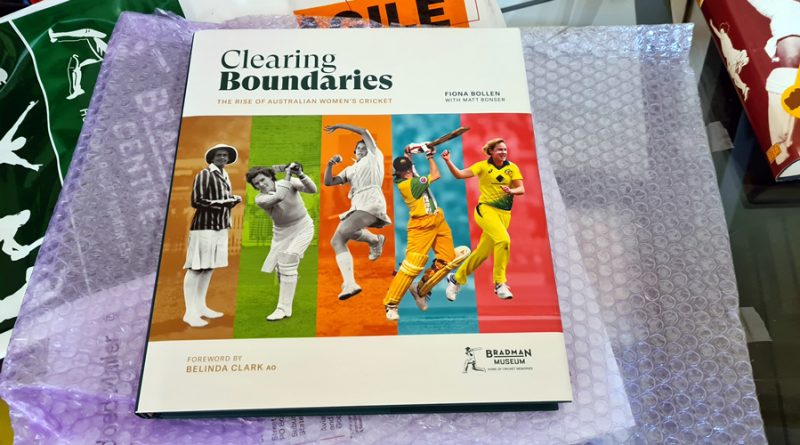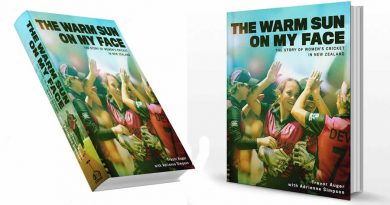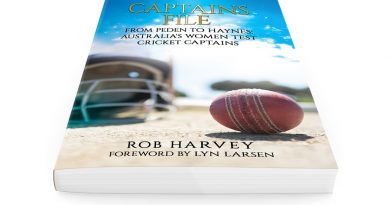Clearing Boundaries: Book Review
Clearing Boundaries: the Rise of Australian Women’s Cricket is a new coffee table style book published by the Bradman Museum. The authors are Fiona Bollen with Matt Bonser. The foreword has been written by former Australian captain, Belinda Clark.
An aptly named book and as one travels through the pages it becomes apparent that the subtitle is even more apt, for this is truly a pictorial history of Australian women’s cricket from the early days of the goldfields to the glory of March 2020.
It is, as promoted, a coffee table book and it fits that description perfectly. Interspersed throughout the collection of photographs, vignettes of significant moments in the history. Some will cause you to stop and read, while others “I’ll get back to that later” as the urge to keep turning the pages to find more pearls is all too addictive.
The book is divided into five parts, Foundation, Rejuvenation, Liberation, Transition and Propulsion, representing five different eras of the women’s game in Australia. While those chapter headings may not mean much here, they do become more significant as you trawl through the history.
There is something for everybody in this book. For history buffs, there is a healthy number of pages dedicated to the early pioneers. Some of the included photos you will not have seen before. A number of them took me by surprise. There’s a lovely depiction of the Siroccos and Fernleas match at the (now) SCG in 1886. Photos of the 19th century with the players in full dresses gives you pause for though. How on earth did they play in those clothes?
Leading into the era of Test cricket, there’s a couple of ripper photos from the England tour of 1934/5. The Edwards sisters walking out to bat for Western Australia – in pants! WA were the only pants wearing team in Australia and oh how smart did Lola and Irene look in more sensible clothing.
There’s a terrific shot Peggy Antonio and her magical wrist. A wonderful photo of Ruby Monaghan padding up. Mollie Flaherty in full flight. Skipper Margaret Peden walking out to bat with Peggy Antonio against Kent. It was Antonio’s 20th birthday and she celebrated by scoring a half century.
I could have stayed in Foundation for longer, but pressed on to Rejuvenation and the post war years. We know what that means. It’s Betty, it’s Una, and it’s Mollie in all their glory. Some wonderful shots of Betty I’d not seen. Gee she had a beautiful high action as she delivered the ball.
There’s a stunning catch by Mary McDonough – the brilliance in the field by the Australian women didn’t just start this century – they have had a reputation in this aspect of the game from the beginning.
There’s the 1950s, a lovely vignette of South Australian Faith Thomas (Coulthard), the first indigenous woman to play for Australia.
The 1960s are poorly represented, but that might be more a reflection on the lack of cricket, but it deserved more than a double page spread of the 1968/9 tour. Missing is Muriel Picton’s tour of NZ in 1961 and Mary Allitt’s tour of England in 1963.
Liberation – the 1970s – women’s cricket and the feminist cause of the 1970s went hand in glove. The first World Cup of cricket, the first time women were allowed to play at Lords. These are key moments in cricket history for sure, but Australia was at the forefront of both and the photos here are a celebration of that.
That World Cup business was pretty much the story of that era as Australia went on a collecting spree. There is good coverage of these important moments, along with focus on the newer legends, Larsen, Matthews, Clark.
Transition covers the latter years of the last century and the early 2000s. The transition is both in clothing – pants – and white ball cricket. Significantly, the merge between the men’s game and the women’s game, all under the umbrella of Cricket Australia.
Propulsion is a steady staple of colourful and dynamic photos of the current age, including the launch of the WBBL, more trophies for the cabinet and then the grand finale, the World Cup final in front of 86,000 people at the MCG.
It is quite a journey. If this book is in the waiting room in some office, you’ll be hoping your appointment is delayed so you can soak up this wonderful photographic history. For the stats minded, there is a healthy dose of stats at the back, but you will keep returning to the photos.
If this is not under the tree on 25th December, then run out on Boxing Day and buy yourself a copy. It’s well worth it.




